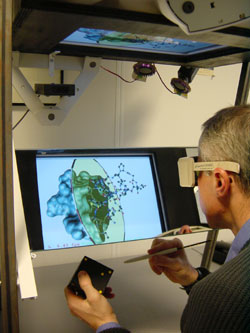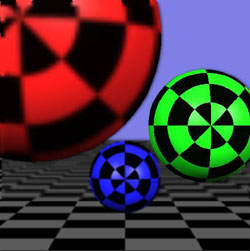
This issue in pdf Archive: |
|
|||||
Personal Space Station handles Virtual 3D Objectsby Jurriaan Mulder CWI developed the Personal Space Station (PSS), an affordable construction for 3D interaction and visualization. Key questions were: how can we realize 3D-interaction and navigation in a virtual reality environment and how can we solve visual perception problems? Virtual reality offers a user the possibility to look at and manipulate a virtual three-dimensional world, generated by a computer. Besides obvious applications in the amusement industry, virtual reality can also contribute considerably to (scientific) research or product development in various areas of application, like biomedical modelling. An example of a virtual reality environment is the ‘Personal Space Station’ (PSS) that is developed at CWI. This environment enables the user to interact with the virtual world in a direct and intuitive way. The environments used so far were often indirect, hard to operate and they lack precision which results in lesser performance, discomfort and weariness for the user. During the development of the Personal Space Station special attention was paid to aspects like image quality, ergonomic use, natural interaction, multi-user cooperation and small initial expense.
The Personal Space Station is built of standard components, entailing minimal costs. The user looks at the monitor via a mirror. This enables the user to bring his hands into the same environment as the virtual 3D-objects without interrupting the visual image. Thus, interaction with virtual objects can take place in a direct, natural and intuitive way. Hand-eye coordination and ‘proprioception’ (the subconscious perception of the position of muscles and joints) are used to the full, which has a favourable effect on user convenience and task performance. The user is ‘attracted’ by the objects he sees; his natural reaction is usually to grab and manipulate them. To facilitate wireless tracking of the interaction a custom optical tracking system was developed. A user has interaction devices in his hands, like a marked pen, cube or thimble. Using infrared lighting, two cameras with infrared-pass filters, and retro-reflective markers these interaction devices can easily be constructed and applied. Device recognition is based on projection-invariant pattern characteristics. Reconstruction is realized through stereo correspondence and so-called epipolar geometry. Once it is determined which point in the left camera image corresponds with which point in the right camera image, and the internal and external camera parameters are known, the position of the matching marker in the 3D environment can easily be determined. A unique aspect of the Personal Space Station is that it enables more people to look at and manipulate the same virtual world simultaneously. By cascading several Personal Space Stations a virtual reality environment is created in which multiple users share the same physical and virtual workspace. This is of the utmost importance for applications where several persons want to cooperate, communicate and interact. For the communication and synchronization of the connected stations, a software model was developed based on a ‘publish and subscribe’ paradigm. Through a central ‘Data Manager’ the important simulation, tracker, and synchronization parameters are communicated. Personal Space Stations will be placed at various universities and research institutes, like the Swammerdam Institute for Life Sciences (SILS) and the departments for Technology Management (former IPO), Biomedical Technology (BMT) and Mathematics and Computer Science of the Technische Universiteit Eindhoven (Eindhoven Technical University). These Personal Space Stations will be applied in different branches of scientific research, like cell biology, biomedical image processing, man-machine interaction and scientific visualization. Apart from the development of the Personal Space Station, research is done on 3D computer graphics and 3D interaction techniques for virtual reality. In the field of 3D computer graphics, for instance, new techniques were developed to draw transparent objects (by way of ‘screen-door’ transparency based on generated pixel masks), to simulate depth of field (based on perception models and Gaussian pyramids) and to improve depth perception (through elimination of faulty depth cues for objects on the screen edges). Link: Please contact: |
|||||



